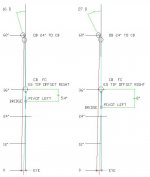I don't even think there is anything magic about Stan's A/B/C alignment points on the quarters and his pivot being 1/2 tip. I think CTE mechanics could be defined using OB thirds or fifths or eights, for example, instead of quarters. And the pivot could be of a different size. But to make any such method work with great proficiency at all cut angles for all CB-OB distances takes considerable experience to ingrain the needed "feel" adjustments, to make it subconscious, to make it continuous.
Using tighter or more frequent references on the object ball could be done. My thoughts are that the system will more closely resemble a contact point or fractional aiming system that really isn't necessary. We would be losing what the visuals creatively accomplish. This is the evolution of the aiming system even after we figure out the correct physical visual alignment.
IOW, a gap in the control we try to assume by using less reference points allows our mind to move to the next step or more automatic control of our aiming. A constant set of directions by a system user creates no rhythm or feedback for the brain to learn and become independent of rational thought. A player striving to consistently get into dead whack isn't going to do it by continuous conscious adjustment of his aiming. Less is more.
I'm glad to see contributors like yourself are providing information that is not hell bent on geometric proofs.
Best,
Mike
